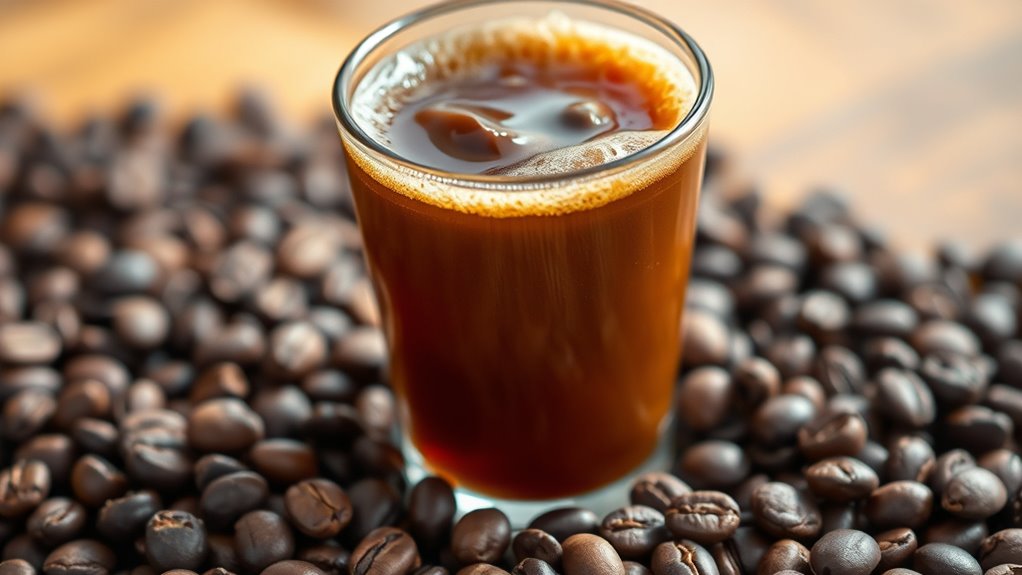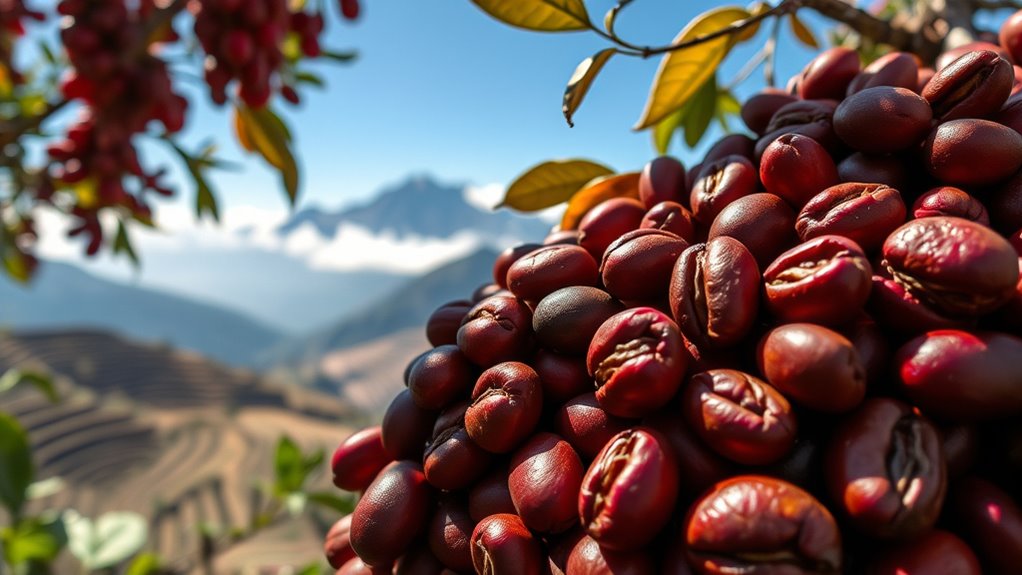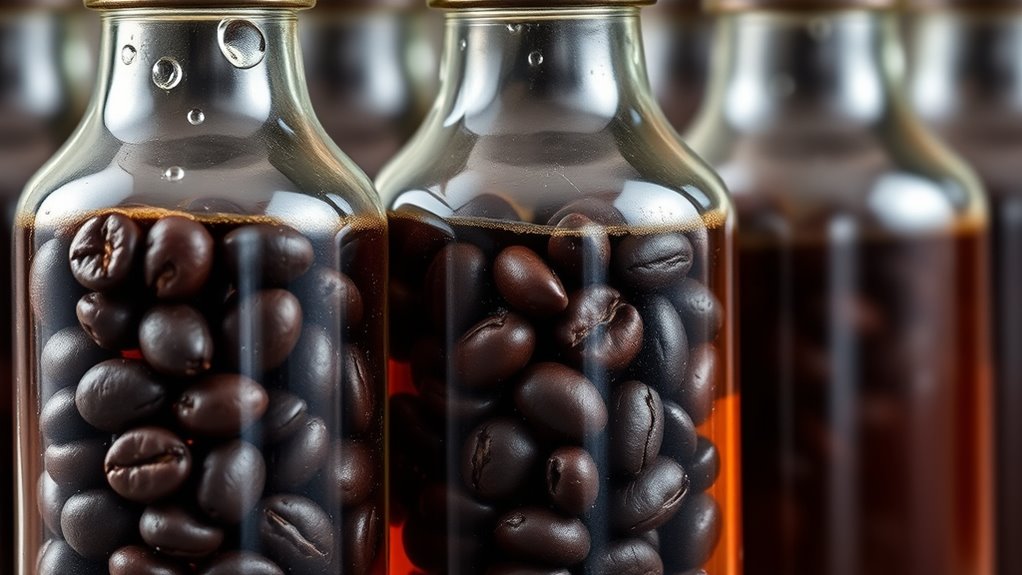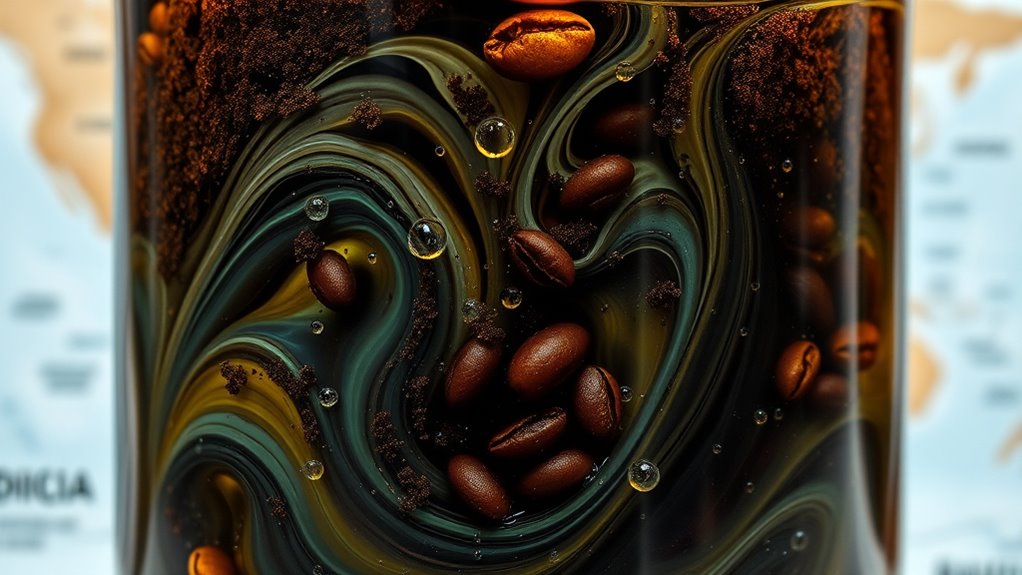Certain origins stand out in cold brew because their beans have unique flavors, acidity, and growth conditions that shine when brewed cold. Regions with high altitudes and specific soil types produce beans with brightness and complexity that benefit from gentle extraction. Processing methods also influence flavor clarity and sweetness. Fine-tuning water chemistry and brewing parameters can highlight these regional traits even more. Keep exploring to discover how different origins can bring exciting flavors to your cold brew experience.
Key Takeaways
- High-altitude, cooler climates produce beans with denser structures and vibrant acidity that extract well in cold brew.
- Regional soil and climate influence flavor profiles, allowing certain origins to develop unique, desirable notes in cold extraction.
- Washed processing methods result in cleaner, brighter flavors that are more effectively showcased through cold brew extraction.
- Beans with specific mineral profiles in water enhance regional traits, amplifying the origin’s distinctive flavors during cold brew.
- Origin-specific roast levels and freshness preservation optimize flavor expression, making certain regions’ beans particularly suited for cold brew.
The Impact of Bean Variety on Cold Brew Flavor

The type of coffee bean you choose plays a crucial role in shaping the flavor of your cold brew. Different bean profiles bring distinct flavor nuances that can elevate or diminish your drink’s appeal. For instance, Arabica beans typically offer a smoother, more nuanced flavor with hints of fruit and acidity, perfect for a delicate cold brew. On the other hand, Robusta beans tend to deliver a bolder, more bitter profile with earthy undertones, which can add depth to your brew. Your choice of bean variety influences the overall balance, aroma, and complexity of your cold brew. By understanding the flavor nuances tied to specific bean profiles, you can tailor your cold brew to match your preferred taste experience. Curiosity can also inspire you to experiment with different beans and brewing techniques, enhancing your appreciation for coffee craftsmanship.
How Processing Methods Influence Cold Brew Extraction

Processing methods play a vital role in determining how efficiently cold brew extracts flavors from coffee beans. Different processing techniques, like washed, natural, or honey processed, create distinct chemical profiles that influence flavor development. For example, washed coffees tend to produce cleaner, brighter notes, while natural processed beans often yield fruity, complex flavors. These differences affect how the coffee interacts with water during extraction, impacting both the strength and clarity of flavors. When you understand how processing methods alter the bean’s composition, you can better predict the resulting cold brew’s profile. Processing techniques shape the foundation of flavor development in your cold brew. Ultimately, processing techniques shape the foundation of flavor development in your cold brew.
The Role of Climate and Altitude in Bean Development

Climate and altitude directly affect how coffee beans develop and mature. Warmer, stable climates often produce beans with richer flavors, while higher altitudes slow growth and enhance complexity. Understanding these factors helps explain why some origins excel in cold brew. Additionally, top beach towns on the East Coast offer diverse environments that can influence local coffee production and flavor profiles.
Climate’s Impact on Beans
Altitude and climate play essential roles in shaping the flavor profiles and quality of coffee beans. Warm, humid climates often produce beans with fruity, bright notes, while cooler temperatures develop more nuanced, balanced flavors. These environmental factors influence how beans should be stored and how their flavors evolve over time. Proper bean storage becomes critical to preserve the delicate aromas and prevent flavor degradation, especially for beans grown in fluctuating climates. Climate also affects the bean’s resilience and how well it pairs with different flavor profiles in cold brew. Understanding these influences helps you select beans that will deliver consistent, vibrant flavors in cold brew, ensuring your drink highlights the unique characteristics shaped by their climate origin. Climate’s influence on flavor development underscores the importance of choosing beans suited to specific environmental conditions for optimal cold brew enjoyment.
Altitude and Bean Maturity
Higher elevations expose coffee plants to cooler temperatures and greater diurnal temperature swings, which substantially influence how beans develop as they mature. These altitude effects slow down the growth process, allowing beans to mature more evenly and develop complex flavors. At higher altitudes, beans ripen gradually, increasing their density and sugar content, which enhances cold brew extraction and flavor clarity. This extended maturation process results in beans with sharper acidity and more vibrant profiles. Additionally, the unique climate conditions at high altitudes often lead to a more pronounced water park effect on flavor development, contributing to a brighter, more nuanced profile compared to lower-altitude origins. Understanding bean maturity in relation to altitude helps explain why certain high-elevation coffees excel in cold brew—they’re matured under conditions that promote the desired chemical development for a crisp, lively cup.
Acidity Levels and Their Effect on Cold Brew Brightness

Acidity levels play a crucial role in shaping the brightness of cold brew coffee, as they influence how lively and vibrant the final cup tastes. When the acidity balance is just right, it enhances the flavor brightness, making the cold brew feel crisp and invigorating. Higher acidity from certain origins adds a zesty, citrus-like note that keeps the coffee engaging and lively. Conversely, too much acidity can make the brew taste sharp or sour, overpowering other flavors. Beans with naturally lower acidity produce a smoother, mellower profile, which may lack the brightness that some drinkers seek. Understanding how acidity influences flavor brightness helps you select the right beans to craft a cold brew that’s lively, well-balanced, and true to its origin’s unique profile. Additionally, brewing techniques can impact how acidity is expressed in your final cold brew.
The Significance of Bean Freshness and Storage

Freshness is one of the most critical factors in ensuring your cold brew tastes vibrant and full of flavor. Proper bean storage is essential for freshness preservation, preventing the beans from losing aroma and oils that contribute to flavor. When beans sit too long or aren’t stored correctly, they oxidize and become stale, dulling your cold brew’s profile. To maximize freshness, store beans in an airtight container away from light, heat, and moisture. Consider the following table for storage insights:
| Storage Method | Ideal Conditions | Impact on Freshness |
|---|---|---|
| Airtight container | Cool, dark place | Preserves aroma |
| Vacuum-sealed bags | Refrigeration or freezer | Extends freshness |
| Glass jar with lid | Room temperature, dark | Maintains quality |
Proper bean storage directly influences your cold brew’s flavor clarity and vibrancy. Additionally, understanding bean freshness and how it impacts flavor can help you make better storage choices.
Roast Level Preferences for Optimal Cold Brew Results

Choosing the right roast level is essential for achieving the best flavor in your cold brew. Lighter roasts often highlight the subtle single origin nuances, allowing unique floral, fruity, or spicy notes to shine through. Medium roasts balance brightness with deeper caramel and chocolate tones, enhancing complexity without overpowering delicate flavors. Dark roasts, while rich and bold, can sometimes mask the nuanced differences of specific origins, but they may also bring out a more robust, full-bodied profile preferred by some. Roast level optimization depends on your taste and the origin of the beans. Experimenting with different roast levels helps you discover which best amplifies the unique characteristics of each origin, ensuring your cold brew is both flavorful and true to its roots. Additionally, understanding the impact of AI in media and entertainment can inspire innovative approaches to flavor profiling and brewing techniques.
Water Quality and Its Interaction With Different Origins

The mineral content in your water can considerably influence how different coffee origins taste in cold brew. A higher mineral level might enhance brightness in some beans while overpowering delicate nuances in others. Additionally, the pH level of your water can alter extraction, impacting the overall flavor profile of each origin. Using water with a balanced mineral composition can help achieve a more harmonious and true-to-origin flavor in your cold brew.
Mineral Content Impact
Mineral content in water plays a crucial role in shaping how different coffee origins develop their flavor in cold brew. The mineral balance affects extraction efficiency, highlighting unique regional qualities. For instance, waters rich in calcium and magnesium can enhance sweetness and body, allowing certain origins to shine. Conversely, high mineral content may overshadow delicate nuances in more subtle beans. Additionally, the pH influence of mineral-rich water impacts acidity levels, which can either brighten or mute specific flavor notes. A well-balanced mineral profile helps highlight the inherent characteristics of each origin, ensuring a harmonious cold brew. Proper mineral levels can also influence water chemistry by affecting solubility and extraction rates, ultimately shaping the final flavor profile. By understanding how mineral content interacts with your beans, you can optimize extraction and bring out the best qualities of each coffee origin.
Ph Level Effects
Since pH levels directly influence how water interacts with coffee grounds, they play a vital role in shaping the flavor profile of cold brew from different origins. Water with an ideal pH can enhance the unique qualities of beans, especially considering factors like soil composition and fermentation process. When water is too acidic or alkaline, it can suppress or exaggerate certain flavors, affecting the final brew. To better understand, consider these key points:
- Slightly acidic water (pH 6-6.5) tends to highlight bright, fruity notes in beans from volcanic soils.
- Neutral pH (7) preserves delicate flavors during extraction, common in high-altitude origins.
- Alkaline water (above pH 7.5) may diminish acidity but can enhance body in beans from mineral-rich soils.
Matching water pH to origin characteristics maximizes cold brew’s potential.
Adjusting Brew Time and Temperature for Each Origin

Adjusting brew time and temperature is essential because each coffee origin has unique characteristics that respond differently to extraction. For lighter, fruitier beans, try shorter brew times with slightly higher temperatures. Richer, chocolatey origins benefit from longer steeping at cooler temps. Your grind size and brewing vessel also influence extraction; a coarser grind in a larger vessel may need more time, while a finer grind accelerates extraction. Use this guide to tailor your cold brew:
| Origin Type | Brew Time | Temperature |
|---|---|---|
| Bright & Fruity | 12-14 hours | 35-40°C (95-104°F) |
| Chocolaty & Rich | 18-20 hours | 10-15°C (50-59°F) |
| Balanced & Versatile | 16 hours | 15-20°C (59-68°F) |
Frequently Asked Questions
How Does Bean Age Affect Cold Brew Flavor Development?
Bean age markedly impacts cold brew flavor development. When you use fresh beans, their vibrant oils and aromas create a richer, more complex taste. Older beans tend to lose freshness, resulting in a duller flavor. Your roast level also influences this; darker roasts often mask bean age’s effects, while lighter roasts highlight freshness. To enjoy ideal flavor, choose freshly roasted beans and adjust your roast level based on your taste preference.
Can Regional Soil Composition Impact Cold Brew Taste?
You might think soil minerals and climatic effects are just background noise, but they actually play a starring role in cold brew flavor. The regional soil composition influences bean mineral content, subtly impacting taste. Climatic effects, like temperature and rainfall, shape the beans’ development, creating unique flavor profiles. So, your favorite cold brew’s complexity is a delightful dance between soil and climate, proving nature’s influence is anything but subtle.
What Role Does Bean Fermentation Play in Flavor Profile?
Fermentation plays a key role in shaping your cold brew’s flavor profile. Longer fermentation durations allow natural yeasts and bacteria to develop deeper, more complex flavors, adding fruity or tangy notes. This process enhances flavor complexity, giving your cold brew a richer, more nuanced taste. So, by controlling fermentation time, you can influence the final flavor, making each batch uniquely vibrant and tailored to your preferences.
Do Specific Harvest Seasons Influence Cold Brew Brightness?
You might think harvest seasons are just about ripeness, but surprisingly, they also influence cold brew brightness. Seasonal variation affects bean acidity and flavor vibrancy, making some harvest timings produce a brighter, more lively cold brew. So, when you sip your brew, remember that harvest timing and seasonal shifts subtly shape its sparkle, turning an ordinary cup into an extraordinary experience. Timing truly is everything in coffee’s seasonal dance.
How Does Bean Drying Method Alter Cold Brew Extraction?
The bean drying method markedly impacts cold brew extraction by affecting the drying process and flavor retention. If beans are sun-dried, they often develop brighter, more vibrant flavors due to slower moisture removal. Mechanical drying can preserve more delicate notes, but may also risk flavor loss if not done carefully. Overall, the drying process shapes how well flavors are retained, influencing the final cold brew’s brightness and complexity.
Conclusion
Ever wonder why some origins just shine in cold brew? The truth is, your choice of beans, processing, climate, and even water all play a role. By understanding these factors, you can craft a brew that highlights each origin’s unique character. So next time you sip, ask yourself: are you really bringing out the best in your coffee? With a little knowledge, you’ll discover flavors that make every cold brew unforgettable.









